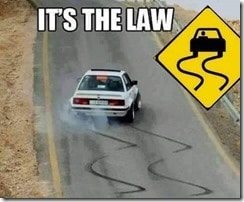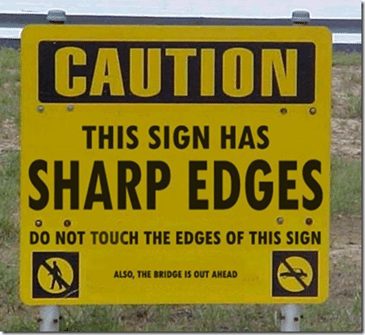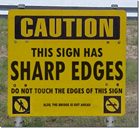Making Sense of Semiotics and Safety
 Semiotics is about symbol (sign, significance, signified and signifyer) as language and text as symbol and, the discourse (power-trajectory) of both (https://en.wikipedia.org/wiki/Semiotics ). Semiotic influence is tertiary and non-conscious. Semiotics is ignored by the safety industry because Safety is bogged down with engineering and regulatory world views. For Safety, if you can’t feel it, see it or touch it – it doesn’t exist. Safety is about ‘workspace’ not ‘headspace’ and ‘groupspace’ (https://safetyrisk.net/safety-engagement/ ).
Semiotics is about symbol (sign, significance, signified and signifyer) as language and text as symbol and, the discourse (power-trajectory) of both (https://en.wikipedia.org/wiki/Semiotics ). Semiotic influence is tertiary and non-conscious. Semiotics is ignored by the safety industry because Safety is bogged down with engineering and regulatory world views. For Safety, if you can’t feel it, see it or touch it – it doesn’t exist. Safety is about ‘workspace’ not ‘headspace’ and ‘groupspace’ (https://safetyrisk.net/safety-engagement/ ).
Yet Safety is the industry that is flooded with signs. When Safety doesn’t know what to do, when Safety can’t see a control, when Safety can’t see a cause, it plonks up a sign. Not that Safety understands the power of signs, the psychology of signs, the unconscious nature of semiotics or the sense of signs but because any noise that fills the airspace must be good. A study of the ‘This Toaster is Hot’ link on this blog is enough evidence of this.
The old belief that ‘something is better than nothing’ is a prevalent mythology in Safety thinking. This is how we end up with Hazardman campaigns , dumb ways to die campaigns and the Love of Zero. I often see the erroneous logic on Linkedin, ‘well at least they are having a go’. Whilst this may be admirable in one sense, it ignores the invisible and unconscious by-products and trade-off associated with that ‘go’. If the campaign devalues Safety itself and clearly doesn’t work according to its own numerical assessment, then it may be time to ask about the by-products of that campaign. Sometimes nothing is better than something. Sometimes Safety does more harm than good.
Recently there were two young boys who fell off rocks at a busy Adelaide beach (http://www.smh.com.au/national/two-boys-11-drown-in-adelaide-beach-tragedy-20160101-gly1s8.html ). A few weeks later a woman’s body was found in exactly the same place (http://www.dailymail.co.uk/news/article-3387699/Woman-s-body-washed-rocks-spot-two-11-year-old-boys-drowned-New-Year-s-Day.html). As tragic and sad as this is, it is of interest how the public and Safety responded to the tragedy and the assumptions that are made about risk and people. For Safety, the rocks are the hazard, we must manage the hazard, name the hazard and control the hazard. Good olde Safety to the rescue, hazards and controls. But the hazard can’t be moved, the beach can’t be banned, people can’t be controlled, the beach can’t be fenced, the risk cannot be eliminated, kids love fun, we can’t afford ‘fun’ police on the beat and obviously people don’t know the risks associated with climbing on rocks. I know let’s put up a sign ‘these rocks are dangerous’. Ah, relief, we have been seen to have done something. I wonder what the by-products of that ‘something’ is?
 Semiosis defines the process of making meaning as mediated by signs and the interpretation and perception of those signs. If we make signs meaningless, we do more harm than good. If someone desires ‘zero harm’ then why would they do things that produce more psychological and cultural harm than good?
Semiosis defines the process of making meaning as mediated by signs and the interpretation and perception of those signs. If we make signs meaningless, we do more harm than good. If someone desires ‘zero harm’ then why would they do things that produce more psychological and cultural harm than good?
Maybe the deductive reasoning of Safety needs to embrace more the abductive nature of human judgment and decision making, the psychology of risk?
Semiotics is the study of how signs and symbols ‘mediate’ and speak to people. Semiosis is a critical part of the perception process, meaning making is not neutral or exclusively rational. We may have one brain but we have three minds (https://vimeo.com/106770292). Thinking isn’t just ‘fast and slow’. Safety isn’t just 1 & 2.
 As much as doing something might look good, I wonder how many signs children have to ignore to get from the bus stop or car park to get to the rocks? I wonder what literacy level the sign will be? I wonder if the sign will be designed semiotically? To communicate to the unconscious? Maybe the sign will ‘act’ like ‘keep out’, it could be a greater attraction for adolescents seeking risk? Maybe the ‘keep out’ sign will be a magnet for risk taking? Maybe the sign will be a homeostasis attractor, telling children where to go for more fun? How do children know which signs to ignore and which signs to read? I wonder if the sign assumes that people are rational and logical? I wonder if people might run into the sign? Hit their head on the sign? Perhaps we need a sign to say the sign is dangerous (This Toaster is Hot’ https://safetyrisk.net/this-toaster-is-hot/)? What happens if there is another drowning? Do we put up two signs?
As much as doing something might look good, I wonder how many signs children have to ignore to get from the bus stop or car park to get to the rocks? I wonder what literacy level the sign will be? I wonder if the sign will be designed semiotically? To communicate to the unconscious? Maybe the sign will ‘act’ like ‘keep out’, it could be a greater attraction for adolescents seeking risk? Maybe the ‘keep out’ sign will be a magnet for risk taking? Maybe the sign will be a homeostasis attractor, telling children where to go for more fun? How do children know which signs to ignore and which signs to read? I wonder if the sign assumes that people are rational and logical? I wonder if people might run into the sign? Hit their head on the sign? Perhaps we need a sign to say the sign is dangerous (This Toaster is Hot’ https://safetyrisk.net/this-toaster-is-hot/)? What happens if there is another drowning? Do we put up two signs?
Some related articles on signs and semiotics:
Do Safety Signs Cause More Harm Than Good?
Safety slogans and safety signs still seem to be one of the most popular forms of communication in the workplace. Those two search terms bring more traffic to this blog than most others combined? There are many articles on this blog about slogans, signs and semiotics (I’ve listed …… Enjoy the rest of the article >>>>>
 why-do-we-ignore-warning-signs-sometimes-with-tragic-results
why-do-we-ignore-warning-signs-sometimes-with-tragic-results
We have all seen and had a chuckle at “Caution This Sign Has Sharp Edges” with the very fine print: “also, the bridge is out ahead”. We have devoted a whole page to stupid and pointless signs, the semiotics of which ……Enjoy the rest of the article >>>>>
A brilliant essay by Max Geyer, submitted as part of his study for the Graduate Certificate in the Psychology of Risk – published here with his permission: Norretranders (1998) provides ample evidence that the unconscious plays a major role in communication. This paper looks at the critical nature of unconscious communication in relation …… Enjoy the rest of the article >>>>>
 How Semiotics Affects The Return To Work Process
How Semiotics Affects The Return To Work Process
A brilliant essay submitted as part of his study for the Graduate Diploma in the Psychology of Risk – by Hayden Collins – …… Enjoy the rest of the article >>>>>
An Introduction to Semiotics and Risk
This video gives a brief introduction to semiotics and the unconscious in communication and decision making about risk. The video gives a visual and verbal overview of signs, signifiers, signified and significance, the foundation of semiotics. Through a study of semiotics we are able to better understand how …… Enjoy the rest of the article >>>>>
 Semiotics and the Unconscious Messages We Send
Semiotics and the Unconscious Messages We Send
I’ve just returned from another mind blowing few days with Dr Rob Long, Craig Ashhurst and a great group of cohorts, as part of my studies for the Graduate Certificate in the Psychology of Risk. This unit was: “Communicating and Consulting About Risk” and mostly covered the …… Enjoy the rest of the article >>>>>
Semiotics and Corporate Logo Fails
Our good friend and author of Its All in The Sign, Max Geyer, has just undertaken a redesign of his company logo as part of an overall revamp of his business. Being “Risk Savvy” he consulted far and wide with his friends and colleagues and the result is pretty ……Enjoy the rest of the article >>>>>
I read with interest a conference proposed for November 2014 entitled ‘Beyond Zero Harm, Human Factors Safety’. The subtitle of the conference is ‘Humanising impacts in safety operations to reengineer safety approach for enhanced productivity and business profitability’. Oh dear. Whilst I am sure such people as John Green will promote some serious …… Enjoy the rest of the article >>>>>
 Semiotics, Semiology and Safety Sense
Semiotics, Semiology and Safety Sense
Dr Rob Long talks about the power of symbols in response to this recent article See also Symbols Have Power When looking for a metaphor or icon to explain safety what do you think might be a thoughtful and intelligent choice for a safety organisation? The study of …… Enjoy the rest of the article >>>>>



Do you have any thoughts? Please share them below